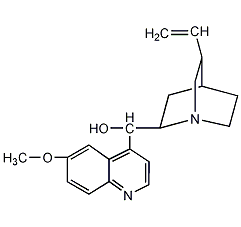
Structural formula
| Business number | 017Q |
|---|---|
| Molecular formula | C20H24N2O2 |
| Molecular weight | 324.42 |
| label |
Isoquinine; Isoquinine; |
Numbering system
CAS number:56-54-2
MDL number:MFCD00135581
EINECS number:200-279-0
RTECS number:VA4725000
BRN number:91866
PubChem number:24899331
Physical property data
1. Characteristics: White shiny crystal. Products containing crystal water will weather in the air. Sensitive to light. Friction can produce light.
2. Density (g/mL,25/4℃) : Undetermined
3. Relative vapor density (g/mL,AIR=1): Undetermined
4. Melting point (ºC): 174~175℃(无水品)
5. Boiling point ( ºC,Normal pressure): Undetermined
6. Boiling point ( ºC,5.2kPa): Undetermined
7. Refractive index: Undetermined
8. Flashpoint (ºC): Undetermined
9. Specific optical rotation (º): [α]D15 +230°(C=1.8, in chloroform),[α]D17 +258°(C=1 , ethanol (中), [α]D17 + 322°(C=1.6,2mol/Lhydrochloric acid)
10. Autoignition point or ignition temperature (ºC): Undetermined
11. Vapor pressure (kPa,25ºC): Undetermined
12. Saturation vapor pressure (kPa,60ºC): Undetermined
13. heat of combustion (KJ/mol): Undetermined
14. Critical temperature (ºC): Undetermined
15. Critical Pressure (KPa): Unconfirmed.�
16. Oil and water (octanol/Water) partition coefficient pair Value: Undetermined
17. Explosion limit (%,V/V): Not OK
18. Lower explosion limit (%,V/V): Not OK
19. Solubility:In Blue fluorescence occurs in dilute sulfuric acid. Very soluble in methanol,1gProduct dissolves in approx.2000mlCold water,800ml Boiling water,360mlEthanol,56mlB�, 1.6mlChloroform, almost insoluble in petroleum ether.
Toxicological data
1, Skin or Eye Irritation: Rabbit, Skin Contact, Standard Draize test, 3%, mild reaction
2, acute toxicity: rat oral LD50: 263mg/kg; rat intravenous LD50: 23mg/kg ; Rat LD50: 60mg/kg; Mouse oral LD50 : 535mg/kg; Mouse abdominal cavity LD50: 135mg/kg; Mouse subcutaneous LDLo: 400mg/kg; Mouse intravenous LD50: 53600mg/kg; Mouse intramuscular LD50: 200mg/kg; Feline vein LD50: 30mg/kg
3 , Other multiple dose toxicity: Rat oral TDLo: 650mg/kg/7W-I
Ecological data
None
Molecular structure data
1. Molar refractive index: 95.78
2. Molar volume (m3/mol):266.3
3. Isotonic specific volume (90.2K):728.7
4. Surface Tension (dyne/cm):56.0
5. Polarizability(10-24cm3): 37.97
Compute chemical data
1. Reference value for hydrophobic parameter calculation (XlogP): 2.9
2. Number of hydrogen bond donors: 1
3. Number of hydrogen bond acceptors: 4
4. Number of rotatable chemical bonds: 4
5. Number of tautomers:
6. Topological molecular polar surface area (TPSA):45.6
7. Number of heavy atoms: 24
8. Surface charge: 0
9. Complexity: 457
10. Number of isotope atoms: 0
11. Determine the number of atomic stereocenters: 4
12. The number of uncertain atomic stereocenters: 0
13. Determine the number of stereocenters of chemical bonds: 0
14. Uncertain number of chemical bond stereocenters: 0
15. Number of covalent bond units: 1
Properties and stability
None
Storage method
This product should be sealed and stored away from light.
Synthesis method
for the Golden Rooster The alkaloids contained in napi are isomers of quinine. It can be obtained by extracting quinine, cinchonine and cinchonidine from cinchona bark, extracting quinine from the mother liquor, and then treating it with sulfuric acid.
Purpose
Chiral catalyst. medicine.
extended-reading:https://www.bdmaee.net/wp-content/uploads/2020/06/70.jpgextended-reading:https://www.newtopchem.com/archives/44131extended-reading:https://www.bdmaee.net/fascat8201-catalyst/extended-reading:https://www.newtopchem.com/archives/44428extended-reading:https://www.newtopchem.com/archives/698extended-reading:https://www.newtopchem.com/archives/44782extended-reading:https://www.newtopchem.com/archives/44180extended-reading:https://www.bdmaee.net/cyclohexylamine-series-products/extended-reading:https://www.newtopchem.com/archives/44359extended-reading:https://www.bdmaee.net/wp-content/uploads/2022/08/drier-butyl-tin-oxide-FASCAT-4101.pdf